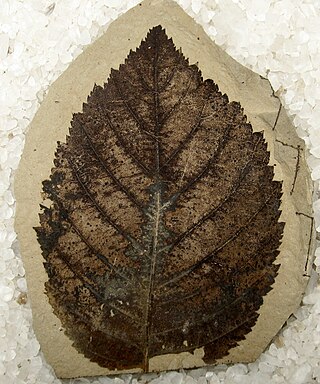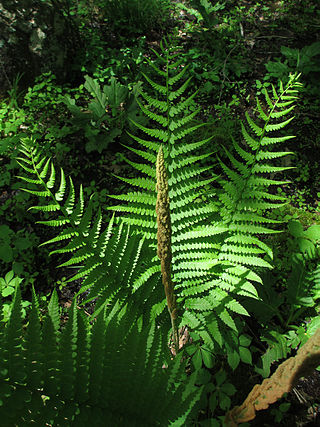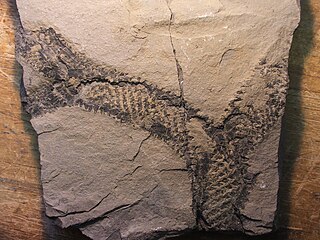
Ginkgoales are a gymnosperm order containing only one extant species: Ginkgo biloba, the ginkgo tree. The order has a long fossil record extending back to the Early Permian around 300 million years ago from fossils found worldwide.

Osmundaceae is a family of ferns containing four to six extant genera and 18–25 known species. It is the only living family of the order Osmundales in the class Polypodiopsida (ferns) or in some classifications the only order in the class Osmundopsida. This is an ancient and fairly isolated group that is often known as the "flowering ferns" because of the striking aspect of the ripe sporangia in Claytosmunda, Osmunda, Osmundastrum, and Plensium. In these genera the sporangia are borne naked on non-laminar pinnules, while Todea and Leptopteris bear sporangia naked on laminar pinnules. Ferns in this family are larger than most other ferns.

Paleobotany, also spelled as palaeobotany, is the branch of botany dealing with the recovery and identification of plant remains from geological contexts, and their use for the biological reconstruction of past environments (paleogeography), and the evolutionary history of plants, with a bearing upon the evolution of life in general. A synonym is paleophytology. It is a component of paleontology and paleobiology. The prefix palaeo- or paleo- means "ancient, old", and is derived from the Greek adjective παλαιός, palaios. Paleobotany includes the study of terrestrial plant fossils, as well as the study of prehistoric marine photoautotrophs, such as photosynthetic algae, seaweeds or kelp. A closely related field is palynology, which is the study of fossilized and extant spores and pollen.

Lepidodendron is an extinct genus of primitive lycopodian vascular plants belonging the order Lepidodendrales. It is well preserved and common in the fossil record. Like other Lepidodendrales, species of Lepidodendron grew as large-tree-like plants in wetland coal forest environments. They sometimes reached heights of 50 metres, and the trunks were often over 1 m (3.3 ft) in diameter. They are often known as "scale trees", due to their bark having been covered in diamond shaped leaf-bases, from which leaves grew during earlier stages of growth. However, they are correctly defined as arborescent lycophytes. They thrived during the Carboniferous Period, and persisted until the end of the Permian around 252 million years ago. Sometimes erroneously called "giant club mosses", the genus was actually more closely related to modern quillworts than to modern club mosses. In the form classification system used in paleobotany, Lepidodendron is both used for the whole plant as well as specifically the stems and leaves.

Archaeopteris is an extinct genus of progymnosperm tree with fern-like leaves. A useful index fossil, this tree is found in strata dating from the Upper Devonian to Lower Carboniferous, the oldest fossils being 385 million years old, and had global distribution.

Calamites is a genus of extinct arborescent (tree-like) horsetails to which the modern horsetails are closely related. Unlike their herbaceous modern cousins, these plants were medium-sized trees, growing to heights of 30–50 meters. They were components of the understories of coal swamps of the Carboniferous Period.

Equisetidae is one of the four subclasses of Polypodiopsida (ferns), a group of vascular plants with a fossil record going back to the Devonian. They are commonly known as horsetails. They typically grow in wet areas, with whorls of needle-like branches radiating at regular intervals from a single vertical stem.

Equisetum sylvaticum, the wood horsetail, is a horsetail native to the Northern Hemisphere, occurring in North America and Eurasia. Because of its lacy appearance, it is considered among the most attractive of the horsetails.

Asteroxylon is an extinct genus of vascular plants of the Division Lycopodiophyta known from anatomically preserved specimens described from the famous Early Devonian Rhynie chert and Windyfield chert in Aberdeenshire, Scotland. Asteroxylon is considered a basal member of the Lycopsida.

The rhyniophytes are a group of extinct early vascular plants that are considered to be similar to the genus Rhynia, found in the Early Devonian. Sources vary in the name and rank used for this group, some treating it as the class Rhyniopsida, others as the subdivision Rhyniophytina or the division Rhyniophyta. The first definition of the group, under the name Rhyniophytina, was by Banks, since when there have been many redefinitions, including by Banks himself. "As a result, the Rhyniophytina have slowly dissolved into a heterogeneous collection of plants ... the group contains only one species on which all authors agree: the type species Rhynia gwynne-vaughanii". When defined very broadly, the group consists of plants with dichotomously branched, naked aerial axes ("stems") with terminal spore-bearing structures (sporangia). The rhyniophytes are considered to be stem group tracheophytes.

Osmundastrum is genus of leptosporangiate ferns in the family Osmundaceae with one living species, Osmundastrum cinnamomeum, the cinnamon fern. It is native to the Americas and eastern Asia, growing in swamps, bogs and moist woodlands.

The cladoxylopsids are an extinct group of plants related to ferns and sphenopsids.

Psilophyton is a genus of extinct vascular plants. Described in 1859, it was one of the first fossil plants to be found which was of Devonian age. Specimens have been found in northern Maine, USA; Gaspé Bay, Quebec and New Brunswick, Canada; the Czech Republic; and Yunnan, China. Plants lacked leaves or true roots; spore-forming organs or sporangia were borne on the ends of branched clusters. It is significantly more complex than some other plants of comparable age and is thought to be part of the group from within which the modern ferns and seed plants evolved.

Lepidodendrales or arborescent lycophytes are an extinct order of primitive, vascular, heterosporous, arborescent (tree-like) plants belonging to Lycopodiopsida. Members of Lepidodendrales are the best understood of the fossil lycopsids due to the vast diversity of Lepidodendrales specimens and the diversity in which they were preserved; the extensive distribution of Lepidodendrales specimens as well as their well-preservedness lends paleobotanists exceptionally detailed knowledge of the coal-swamp giants’ reproductive biology, vegetative development, and role in their paleoecosystem. The defining characteristics of the Lepidodendrales are their secondary xylem, extensive periderm development, three-zoned cortex, rootlike appendages known as stigmarian rootlets arranged in a spiralling pattern, and megasporangium each containing a single functional megaspore that germinates inside the sporangium. Many of these different plant organs have been assigned both generic and specific names as relatively few have been found organically attached to each other. Some specimens have been discovered which indicate heights of 40 and even 50 meters and diameters of over 2 meters at the base. The massive trunks of some species branched profusely, producing large crowns of leafy twigs; though some leaves were up to 1 meter long, most were much shorter, and when leaves dropped from branches their conspicuous leaf bases remained on the surface of branches. Strobili could be found at the tips of distal branches or in an area at the top of the main trunk. The underground organs of Lepidodendrales typically consisted of dichotomizing axes bearing helically arranged, lateral appendages serving an equivalent function to roots. Sometimes called "giant club mosses", they are believed to be more closely related to extant quillworts based on xylem, although fossil specimens of extinct Selaginellales from the Late Carboniferous also had secondary xylem.

Adoketophyton is a genus of extinct vascular plants of the Early Devonian. The plant was first described in 1977 based on fossil specimens from the Posongchong Formation, Wenshan district, Yunnan, China. These were originally named Zosterophyllum subverticillatum; later the species was transferred to a new genus as Adoketophyton subverticillatum. One cladistic analysis suggested that it is a lycophyte, related to the zosterophylls. Other researchers regard its placement within the vascular plants as uncertain.

Tetraxylopteris is a genus of extinct vascular plants of the Middle to Upper Devonian. Fossils were first found in New York State, USA. A second species was later found in Venezuela.

Ventarura is a genus of extinct vascular plants of the Early Devonian. Fossils were found in the Windyfield chert, Rhynie, Scotland. Some features, such as bivalved sporangia borne laterally and the anatomy of the xylem, relate this genus to the zosterophylls. Other features are unclear due to poor preservation.
Rotafolia is a genus of the extinct Sphenophyllales horsetails. The species Rotafolia songziensis was first described as Bowmanites songziensis in 1984, based on a fossilized strobilus, and transferred to the new genus Rotafolia in 2005.

Asterotheca is a genus of seedless, spore-bearing, vascularized ferns dating from the Carboniferous of the Paleozoic to the Triassic of the Mesozoic.

Macroneuropteris is a genus of Carboniferous seed plants in the order Medullosales. The genus is best known for the species Macroneuropteris scheuchzeri, a medium-size tree that was common throughout the late Carboniferous Euramerica. Three similar species, M. macrophylla, M. britannica and M. subauriculata are also included in the genus.



















